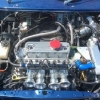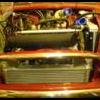Sometime in the not too distant future I plan to convert my mini over to EFI using a Jenvey DCOE type throttle body & a Polestar Systems ECU, in order for the setup to work well the engine will need to be fitted with a Cam Position Sensor, so I've been thinking of ways to do this.
The MPI block has a sensor mounted in the space used by the old mechanical fuel pump and the MPI cam has a suitable lobe in place of the fuel pump drive lobe. However I am using an older A+ block & the cam I have has the fuel pump drive lobe, this all makes using an MPI based setup somewhat more complicated. That is not to say it couldn't be done, I could easily make up a mounting for the sensor to fit on the fuel pump mounting but then I need to somehow arrange a lobe structure on the cam to trigger the sensor, the only way I can think of is to turn off the existing fuel pump lobe leaving a cylindrical section on the camshaft to which I could mount a split collar with a lobe to trigger the sensor. I must admit that the thought of sticking the camshaft in a lathe to turn off the fuel pump lobe is slightly terrifying!
Another way is to mount the sensor on the timing cover and pick up off of something in the timing gear, options include make up a collar that fits around the threaded end of the cam and is sandwiched in between timing gearwheel & nut, a ring or half ring that is fastened on with the vernier timing gear lock screws, clearance with the timing cover might be an issue with these two methods, the final option for the timing cover mounted sensor would be to machine away a small amount of the threaded portion of the cam so that it has a half circle section, I'm not sure how much meat is left proud of the timing gear nut but this way would not cause any clearance issues with the timing cover.
the last (and least favourite) location is to use the distributor drive and modify an old distributor body to house the sensor, this would be easy in regards to being pretty much "Plug & Play" but the space that used to be occupied by the distributor (and oil filter head) will have a front mounted radiator & associated hoses in its place.
Anyone have any thoughts on this?
Edited by Deejayry, 02 September 2017 - 09:59 AM.
















